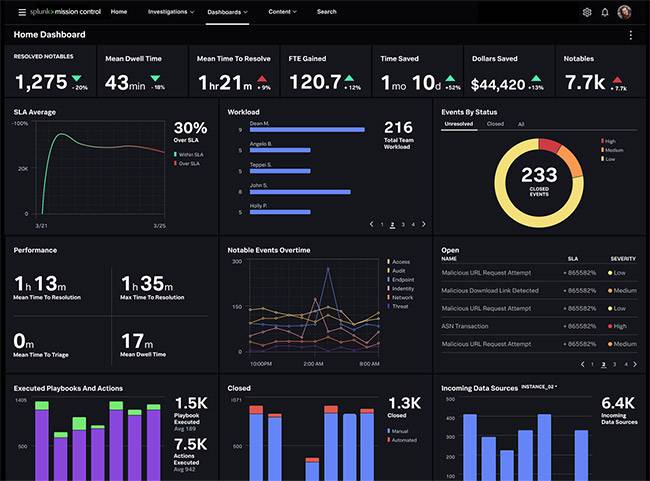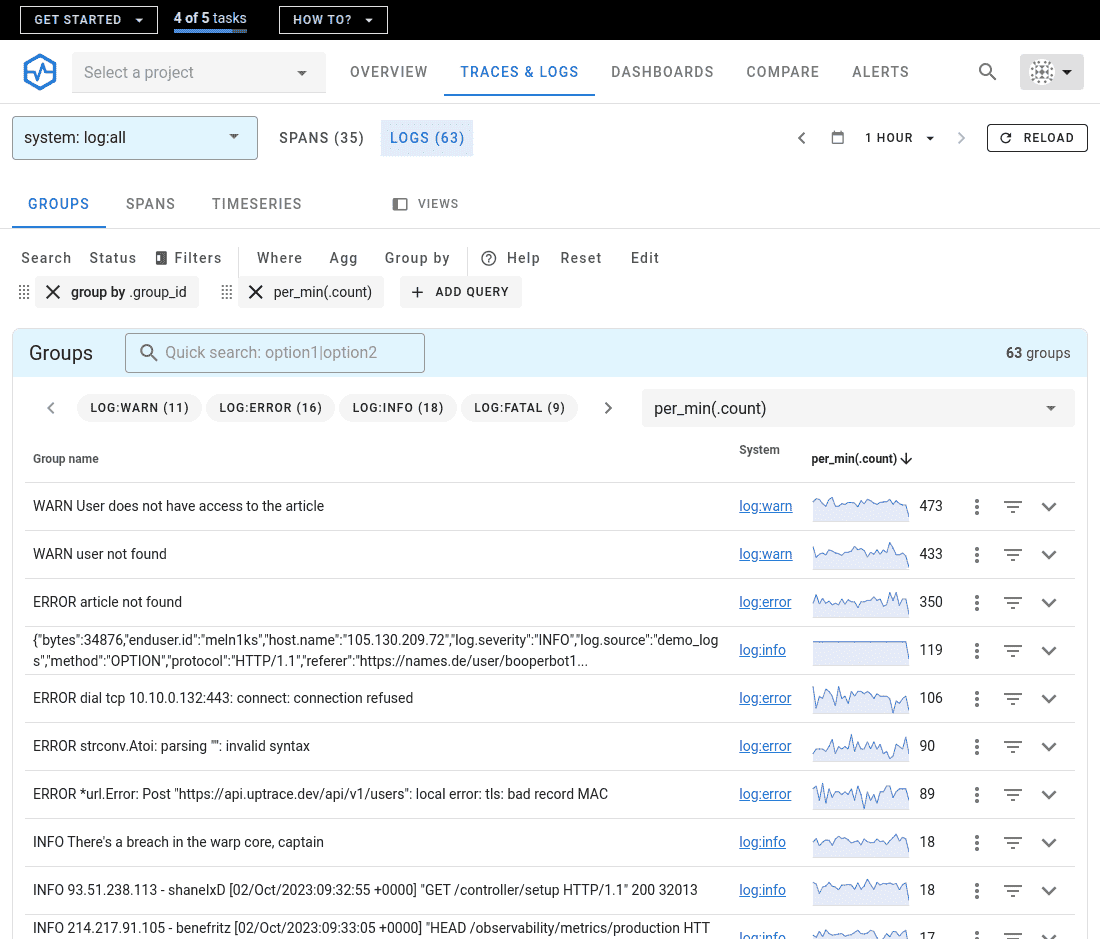Elastic vs Splunk [Detailed Comparison 2025]
Elasticsearch and Splunk are two leading solutions renowned for their capabilities in processing, analyzing, and visualizing large datasets in real-time. Both platforms have carved out significant roles in the fields of data analytics and log management, each offering unique features tailored to different needs. This article aims to provide a comprehensive comparison of Elasticsearch and Splunk, highlighting their strengths and weaknesses, and introducing Uptrace as a compelling alternative.
What Is Elasticsearch?
Elasticsearch is an open-source, distributed search and analytics engine built on Apache Lucene. It is designed to handle large-scale data indexing and retrieval operations. Elasticsearch is commonly used for log and event data analysis, full-text search, and real-time analytics. Its powerful query language and ability to scale horizontally make it a popular choice for enterprises needing a flexible and high-performance search engine.
Key Features of Elasticsearch
- Scalability: Easily handles large volumes of data by distributing it across multiple nodes.
- Real-Time Search and Analytics: Provides near-instantaneous search results and real-time analytics capabilities.
- Full-Text Search: Offers advanced full-text search features, including support for complex queries and multi-language processing.
- Open-Source: Available under an open-source license, allowing for extensive customization and integration.
What Is Splunk?
Splunk is a proprietary platform designed for searching, monitoring, and analyzing machine-generated big data. It excels in log management, security information, and event management (SIEM). Splunk's intuitive interface and powerful data processing capabilities make it a go-to solution for IT operations, security, and business analytics.
Key Features of Splunk
- Unified Data Platform: Centralizes data collection, storage, and analysis in a single platform.
- Advanced Analytics: Offers machine learning and AI-driven analytics for proactive monitoring and incident detection.
- User-Friendly Interface: Provides a visual and interactive interface for easy data exploration and dashboard creation.
- Extensive Integrations: Supports a wide range of data sources and third-party integrations, making it highly versatile.
 Example of a Splunk dashboard displaying various analytics and real-time data insights.
Example of a Splunk dashboard displaying various analytics and real-time data insights.
Comparing Elasticsearch and Splunk
To provide a clearer picture of how Elasticsearch and Splunk stack up against each other, let's break down their features, performance, and other key aspects in a detailed comparison.
| Feature | Elasticsearch | Splunk |
|---|---|---|
| Scalability | High scalability with horizontal scaling across nodes | Scalable but may require more resources for larger datasets |
| Real-Time Capabilities | Near-instantaneous search and analytics | Real-time processing but can be resource-intensive |
| Data Ingestion | Supports various methods (APIs, Logstash, Beats) | Robust ingestion with Universal and Heavy Forwarders |
| Query Language | Powerful Query DSL for complex searches | SPL for creating queries and visualizations easily |
| Search Capabilities | Advanced full-text search with complex queries | Comprehensive search with AI-driven analytics |
| User Interface | CLI-based with some graphical tools | Highly intuitive and user-friendly |
| Cost | Open-source with optional paid features | Proprietary with licensing costs based on data volume |
| Integration | Extensive integrations with various data sources | Wide range of third-party integrations |
| Use Cases | Log and event data analysis, full-text search, analytics | IT operations, security, business analytics |
Scalability and Performance
Elasticsearch: Known for its ability to scale horizontally, Elasticsearch can distribute data across multiple nodes, making it highly scalable and efficient in handling large datasets. This is particularly advantageous for real-time applications requiring quick search and indexing.
Splunk: While Splunk is also scalable, it often requires more resources and infrastructure to maintain performance as the data volume grows. Its ability to process real-time data is robust but can be more resource-intensive compared to Elasticsearch.
Data Ingestion and Processing
Elasticsearch: Supports a variety of data ingestion methods, including RESTful APIs, Logstash, and Beats, allowing for flexible and efficient data handling. It is well-suited for both structured and unstructured data.
Splunk: Offers comprehensive data ingestion capabilities with its Universal Forwarder and Heavy Forwarder, which streamline data collection and pre-processing. Splunk's platform is designed to handle diverse data sources effectively.
Query and Search Capabilities
Elasticsearch: Provides a powerful Query DSL (Domain Specific Language) that supports complex searches and aggregations. Its full-text search capabilities are highly advanced, making it a strong choice for applications requiring detailed search functionality.
Splunk: Features an easy-to-use Search Processing Language (SPL) that simplifies the creation of complex queries and visualizations. Splunk's search capabilities are enhanced by AI-driven analytics, making it effective for identifying patterns and insights.
Cost and Licensing
Elasticsearch: Being open-source, Elasticsearch offers a cost-effective solution with flexibility in deployment. However, advanced features and enterprise support require a subscription to Elastic's commercial offerings.
Splunk: As a proprietary platform, Splunk's licensing costs are based on data volume, which can become expensive for large-scale deployments. This cost factor can be a significant consideration for organizations with extensive data processing needs.
User Interface and Experience
Elasticsearch: Primarily CLI-based with some graphical tools available through Kibana. It may require a steeper learning curve for users unfamiliar with command-line interfaces.
Splunk: Offers a highly intuitive and interactive user interface that facilitates easy data exploration and dashboard creation. Its user-friendly design is a major advantage for non-technical users.
Conclusion: Which Tool is Better?
Both Elasticsearch and Splunk have their strengths and are suited for different use cases.
- Elasticsearch excels in scalability, real-time search, and cost-effectiveness, making it ideal for organizations looking for a flexible and high-performance search engine without significant licensing costs.
- Splunk stands out with its advanced analytics, user-friendly interface, and extensive integration capabilities, making it a strong choice for IT operations, security, and business analytics where ease of use and advanced features are critical.
Ultimately, the choice between Elasticsearch and Splunk depends on your specific needs, budget, and technical requirements. For enterprises seeking an open-source solution with powerful search capabilities, Elasticsearch is a compelling option. On the other hand, for those prioritizing advanced analytics and a seamless user experience, Splunk offers substantial value.
Why Uptrace May Be a Better Choice
Uptrace is an open-source distributed tracing and metrics platform that provides a comprehensive solution for monitoring and troubleshooting complex systems. It combines the best features of Elasticsearch and Splunk while addressing some of their limitations.
Key Advantages of Uptrace
- Unified Monitoring: Uptrace integrates distributed tracing and metrics, offering a holistic view of system performance and dependencies.
- Ease of Use: Features an intuitive interface and out-of-the-box integrations, making it easy to deploy and use.
- Cost-Effective: As an open-source platform, Uptrace eliminates licensing costs while providing enterprise-grade capabilities.
- Performance and Scalability: Designed to handle large-scale data with low latency, ensuring real-time insights and quick issue resolution.
 Uptrace dashboard showcasing real-time monitoring and tracing capabilities.
Uptrace dashboard showcasing real-time monitoring and tracing capabilities.
See also:
- Top Distributed Tracing Tools updated for 2025
- Structured logging best practices
- Golang Logging Libraries in 2025
- Open source log management tools in 2025
- Top OpenTelemetry backends for storage and visualization
Conclusion
Elasticsearch and Splunk are powerful tools in the realm of data analytics and log management, each with its unique strengths and use cases. Elasticsearch excels in search and indexing performance, while Splunk offers advanced analytics and a user-friendly interface. However, for those seeking a unified, scalable, and cost-effective solution, Uptrace emerges as a superior alternative. By leveraging Uptrace, organizations can achieve comprehensive monitoring and troubleshooting capabilities without the high costs associated with proprietary platforms.
Choosing the right tool depends on your specific needs and priorities, but with Uptrace, you can enjoy the best of both worlds: powerful features and affordability.
You may also be interested in: